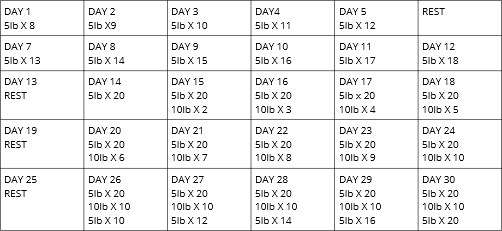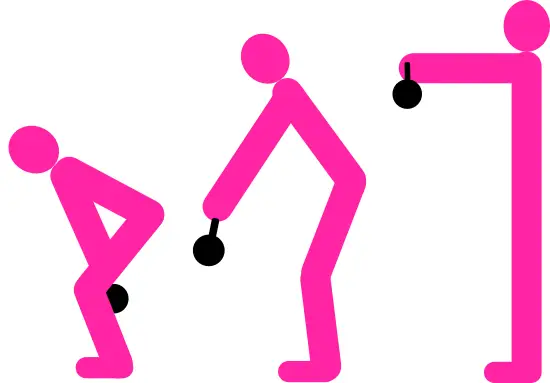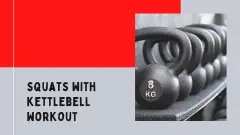Kettelbells are ideal to use for home workouts because they are very versatile and quite compact. You can use them for upper and lower body strength, core and even cardio training. The kettlebell swing is one of the best kettlebell exercises, because it works multiple muscle groups and is also good for coordination and stability. This post covers the benefits of kettlebells, how to use them and what to buy. It also includes a kettlebell swing for beginners 30 day challenge.
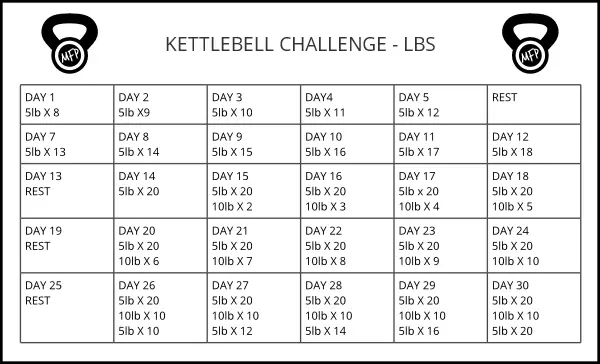

Working with kettlebells can burn fat, tone muscles and improve endurance, balance and agility. Kettlebell benefits include:
- Large, sweeping movements are easy. This means you can take muscles and joints through a wide range of movement.
- The centre of gravity of the weight is not in your hand. This challenges balance, core strength and coordination.
- The handle allows for letting go and passing/catching, which also trains core strength and improves coordination.
- Being able to do large movements and pass the kettlebell from hand to hand means a continuous, flowing aerobic workout is possible (with lighter weights).
- Because the kettlebell is easy to hold and move around, you can do arm and leg movements at the same time, giving an all-over body workout. Being able to train several muscle groups at once means you can cut down on your workout time.
Technique points for working with kettlebells
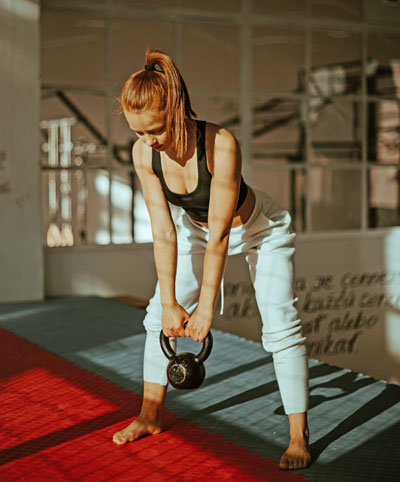
- Movements should be smooth and controlled – which means you need to use a manageable weight
- You should maintain core engagement throughout
- Your lower back shouldn’t arch to help get weights up in the air. If you find yourself doing this, either you need to use a lower weight, or you have done enough reps and need to rest.
- When straightening at the knees, don’t force the joint backwards
Number of reps guide
There are 3 main types of training effect: muscular strength, muscular endurance and aerobic endurance. The lighter the weight and the more reps you do, the more you move towards endurance training. The following is a rough guide to reps numbers.
- Muscular strength: The muscles get stronger and able to lift more weight. Choose a weight that you can do between 8 and 15 reps with to train for strength.
- Muscular endurance: The muscles become able to do more reps for a given weight. Choose a weight that you can do 16-25 reps with to train for muscular endurance.
- Aerobic endurance: The heart becomes able to deliver more blood to the working muscles and the muscles become more efficient at breaking down glucose to make energy. To train for aerobic endurance with kettlebells, choose a weight you can do 30+ reps with and don’t rest between exercises.
How to get started – choosing and buying kettlebells
- The different types available are vinyl, plain cast iron and coated cast iron. Vinyl kettlebells are cheaper and a good option to start with. However, if you find you like working with them and want to move up the weights, cast iron ones are better to grip. Coated cast iron gives some cushioning, so they are less likely to damage flooring etc.
- The most important thing for comfort is that the handle is wide enough for both your hands to grip. You would think this is an obvious design feature, but it’s surprising how many have handles which are too small to be comfortable.
- Start with small weights – only move up to bigger weights when you are confident you are working with good technique. Remember that you should be able to maintain core abdominal engagement throughout the movements. You should only progress your weights when you can do this. Remember also that if you want to make it more cardio, you need to use light weights and high reps.
- Adjustable kettle bells might seem like a good idea to save money and storage space, but in practice it interrupts your workout having to keep changing the weights.
Kettlebell swing for beginners
The kettlebell swing is one of the best kettlebell exercises for whole body strength training. The squat part works all the leg muscles, the swing itself works the upper body and the core has to work to stabilise the movement.
How to do the kettlebell swing
- Stand with your feet a bit wider than hip distance
- Bend your knees and take the kettlebell between your legs. Keep your back straight and your head in line with your spine.
- Engage your core muscles as you straighten your legs, at the same time lifting the kettle bell out in front of your body.
- Stop when your arms are parallel to the floor and reverse the movement, bending your knees as you take the kettle bell back through your legs.
- The movement should be smooth and controlled. There shouldn’t be any jerking or snapping at the joints. If you can’t do the movement smoothly, try a smaller weight.
You’ll need either 2kg and 4kg kettlebells or 5lb and 10lb. You could buy them individually, but sets are usually better value. If you buy a set of 3 which includes a heavier kettlebell, you can use this in the future when you’ve got used to kettlebell training. Before you do the challenge each day, you should warm up your muscles and joints by doing 10 reps without any weight. (Read more about warm ups here.) Please also read my general exercise safety guidelines.
Kettlebell swing challenge in kg
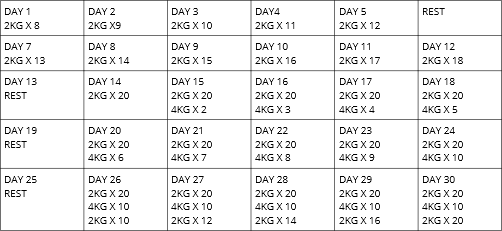
Kettlebell swing challenge in lbs
